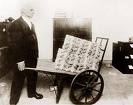 “It was horrible. Horrible! Like lightning it struck. No one was prepared. The shelves in the grocery stores were empty. You could buy nothing with your paper money.” – Harvard University law professor Friedrich Kessler on the Weimar Republic hyperinflation (1993 interview)
“It was horrible. Horrible! Like lightning it struck. No one was prepared. The shelves in the grocery stores were empty. You could buy nothing with your paper money.” – Harvard University law professor Friedrich Kessler on the Weimar Republic hyperinflation (1993 interview)Some worried commentators are predicting a massive hyperinflation of the sort suffered by Weimar Germany in 1923, when a wheelbarrow full of paper money could barely buy a loaf of bread. An April 29 editorial in the San Francisco Examiner warned:
- “With an unprecedented deficit that’s approaching $2 trillion, [the President’s 2010] budget proposal is a surefire prescription for hyperinflation. So every senator and representative who votes for this monster $3.6 trillion budget will be endorsing a spending spree that could very well turn America into the next Weimar Republic.”1
In an investment newsletter called Money Morning on April 9, Martin Hutchinson pointed to disturbing parallels between current government monetary policy and Weimar Germany’s, when 50% of government spending was being funded by seigniorage – merely printing money.2 However, there is something puzzling in his data. He indicates that the British government is already funding more of its budget by seigniorage than Weimar Germany did at the height of its massive hyperinflation; yet the pound is still holding its own, under circumstances said to have caused the complete destruction of the German mark. Something else must have been responsible for the mark’s collapse besides mere money-printing to meet the government’s budget, but what? And are we threatened by the same risk today? Let’s take a closer look at the data.
History Repeats Itself – or Does It?
In his well-researched article, Hutchinson notes that Weimar Germany had been suffering from inflation ever since World War I; but it was in the two year period between 1921 and 1923 that the true “Weimar hyperinflation” occurred. By the time it had ended in November 1923, the mark was worth only one-trillionth of what it had been worth back in 1914. Hutchinson goes on:
“The current policy mix reflects those of Germany during the period between 1919 and 1923. The Weimar government was unwilling to raise taxes to fund post-war reconstruction and war-reparations payments, and so it ran large budget deficits. It kept interest rates far below inflation, expanding money supply rapidly and raising 50% of government spending through seigniorage (printing money and living off the profits from issuing it). . . .
“The really chilling parallel is that the United States, Britain and Japan have now taken to funding their budget deficits through seigniorage. In the United States, the Fed is buying $300 billion worth of U.S. Treasury bonds (T-bonds) over a six-month period, a rate of $600 billion per annum, 15% of federal spending of $4 trillion. In Britain, the Bank of England (BOE) is buying 75 billion pounds of gilts [the British equivalent of U.S. Treasury bonds] over three months. That’s 300 billion pounds per annum, 65% of British government spending of 454 billion pounds. Thus, while the United States is approaching Weimar German policy (50% of spending) quite rapidly, Britain has already overtaken it!”
And that is where the data gets confusing. If Britain is already meeting a larger percentage of its budget deficit by seigniorage than Germany did at the height of its hyperinflation, why is the pound now worth about as much on foreign exchange markets as it was nine years ago, under circumstances said to have driven the mark to a trillionth of its former value in the same period, and most of this in only two years? Meanwhile, the U.S. dollar has actually gotten stronger relative to other currencies since the policy was begun last year of massive “quantitative easing” (today’s euphemism for seigniorage).3 Central banks rather than governments are now doing the printing, but the effect on the money supply should be the same as in the government money-printing schemes of old. The government debt bought by the central banks is never actually paid off but is just rolled over from year to year; and once the new money is in the money supply, it stays there, diluting the value of the currency. So why haven’t our currencies already collapsed to a trillionth of their former value, as happened in Weimar Germany? Indeed, if it were a simple question of supply and demand, a government would have to print a trillion times its earlier money supply to drop its currency by a factor of a trillion; and even the German government isn’t charged with having done that. Something else must have been going on in the Weimar Republic, but what?
No comments:
Post a Comment